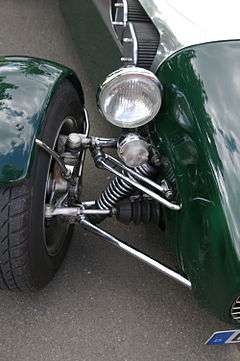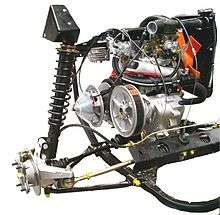Coilover



A coilover is an automobile suspension device. "Coilover" is short for "coil spring over shock". It consists of a shock absorber with a coil spring encircling it. The shock absorber and spring are assembled as a unit prior to installation, and are replaced as a unit when the shock absorber has leaked. This provides damping without torsional loads. Some coilovers allow adjustment of ride height and preload, using a simple threaded spring perch similar to a nut. More advanced adjustable coilover systems use a threaded shock body, along with an adjustable lower mount for ride height adjustment, while an adjustment knob is used to adjust damping. Stiffness is changed by switching the spring for one with a different spring rate.
The coilover style of spring placement is a component of the MacPherson strut suspension system, which uses a design of anti-roll bar as a longitudinal constraint.
Coilovers are different from struts or independently mounted shock absorbers.
There are two types of coilovers, full coilovers and slip on coilovers. The full coilovers are matched up with a shock from the factory, while slip on coilovers are mostly adjustable springs.
Benefits of Coilovers
- Coilovers provide tight packaging for shocks and springs
- Assembly line installation is easier with distinct packages
- Easy replacement with aftermarket coilovers
- Aftermarket coilovers can offer many adjustments including ride height
Disadvantages of Coilovers
- Increases shock wear due to spring side load
- Increased shock bushing wear
- More expensive to manufacture than separate shock and spring
References
External links
- http://www.pirate4x4.com/tech/billavista/coilovers/Part_1/, in-depth explanation of coilovers and their function.
- "http://www.pirate4x4.com/tech/billavista/coilovers/Part_2/"
- http://www.corbymotorsport.com/tuning_guide.php, article related to setting up coilovers
- http://accutuneoffroad.com/articles/shock-tuning-101/, how to tune rebuildable coilovers